Monitoring populations plays a huge role in how the Wyoming Game and Fish Department manages wildlife. You may spot helicopters flying as biologists count pronghorn, elk or other big game. These counts are turned into population estimates that guide management decisions like how many hunting licenses to issue or what areas should be the focus of habitat restoration projects.
These might be the most visible population surveys Game and Fish completes, but some surveys occur under the cover of darkness. One of these surveys is conducted not just at night but often on the darkest nights of the summer — those that fall around each month’s new moon.
This almost mythical sounding survey is not for elk, pronghorn or any other terrestrial wildlife. Hydroacoustic surveys are used to monitor fish populations in large lakes and reservoirs across Wyoming.
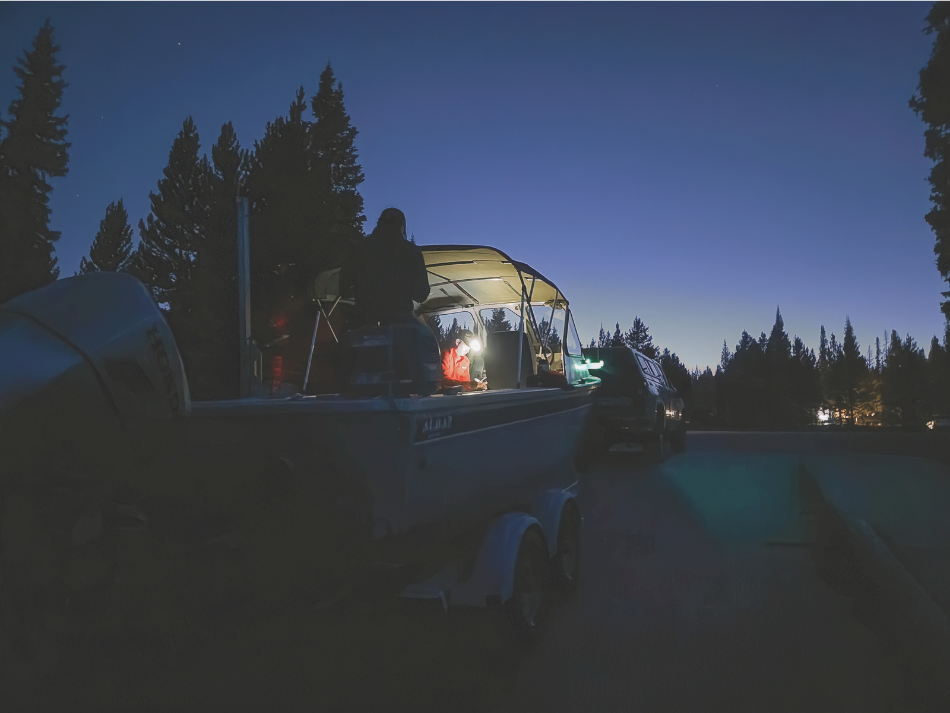
Biologists prepare to launch the boat at Rob Roy Reservoir to start collecting hydroacoustic data after nautical twilight.
BELOW THE WAVES
As the name implies, hydroacoustic surveys utilize underwater (hydro) sound (acoustic) waves to detect the presence of fish. This might sound familiar to some anglers, as it uses similar technology found in commercially-available fish finders. The differences between the two stem from the technology built into the sensors, the method used to collect the data and the computer processing that occurs afterward to derive a population estimate from the data collected.
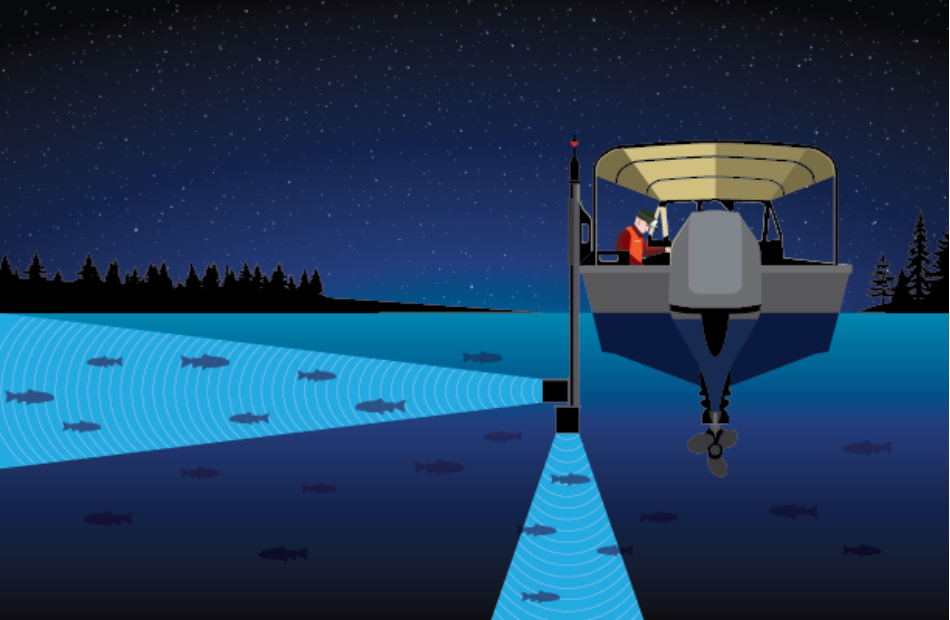
In hydroacoustic surveys, two transducers send sound waves into the water. One of them points down and the other to the side. This allows fish below and to the side of the watercraft to be counted.
Commercially-available fish finders typically have a transducer mounted to the stern of a boat. It sits just below the water surface and sends sound waves down. Sound waves bounce off fish or the bottom, and as those waves reflect back to the transducer it allows the device to produce a map of the water column and what’s in it. The beam of a commercial transducer is wide, allowing it to depict a wide swath of the bottom. This can help detect more fish, but makes the position of the fish less precise.
The transducers used in hydroacoustic surveys are more advanced. First, two transducers are used —– one points down like a traditional fish finder, the other points sideways. The side-looking transducer allows fish near the surface of the water to be detected and counted. Transducers used for surveys are much larger than those typically used for fishing. Fish finder transducers are typically a few inches long, but those used for hydroacoustic estimates are about the size of a basketball. The size is partly because each housing contains four transducers. Each transducer has a narrower beam than those in commercial products, and information from the four beams is combined by a computer program to accurately pinpoint the location of a fish — providing detailed information about how far fish are from the transducer and their depth.
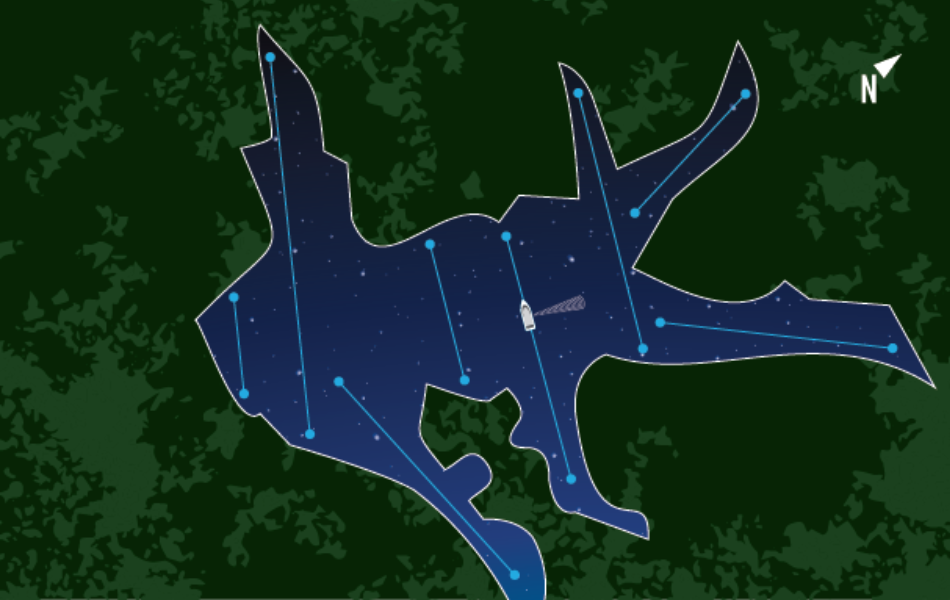
Fish biologists planned and mapped their pathways of travel at Rob Roy Reservoir prior to setting out. This ensured the best population counts for the reservoir. Once adequate data was collected from a specific route, the equipment was turned off and the boat continued to the starting point of the next path.
DATA COLLECTION
Imagine a glassy, calm reservoir under a dark, starlit sky with only a sliver of moonlight. Those are the perfect conditions for collecting hydroacoustic data. Data is collected by driving slow lines in a boat as the transducers map the fish below. Calm conditions prevent the transducers from registering bubbles created by wind and waves. The need for darkness is driven by the behavior of fish. Some fish, like kokanee salmon, exhibit schooling behaviors under moonlight when they can see each other and gather too closely together to be accurately counted. Under a new moon, the lack of light makes schooling more difficult and spreads out fish enough to make them easier to count.
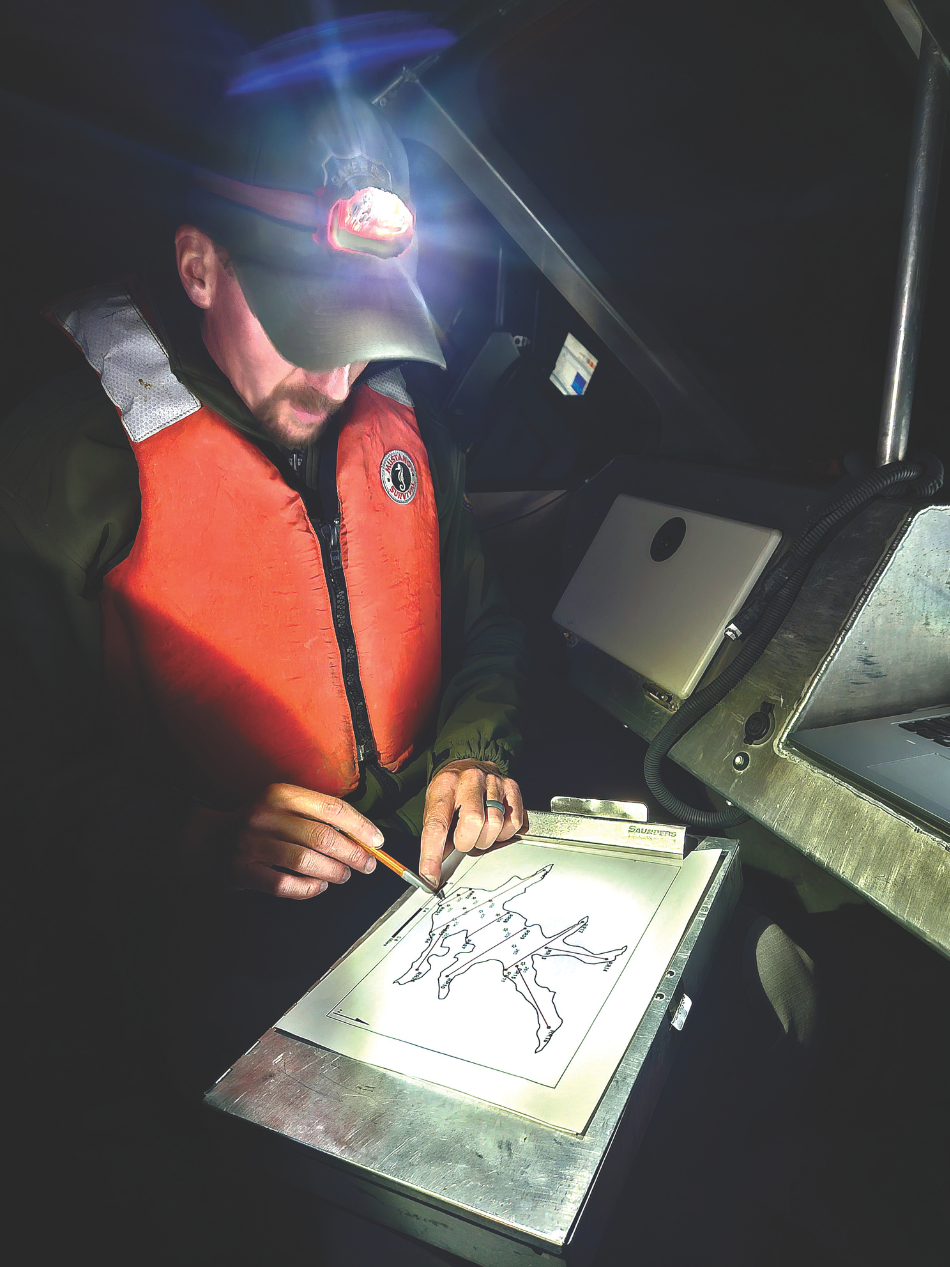
Neebling references a map of Rob Roy Reservoir to check the locations of each hydroacoustic transect that will be sampled.
The hydroacoustic surveys provide precise counts of fish in each depth zone throughout the reservoir, but it cannot determine the fish species. To assign species to each counted fish, hydroacoustic surveys are accompanied by gillnetting, which allows biologists to physically catch and measure fish. This allows them to understand what species and sizes of fish are present in each depth and use that data to assign fish recorded in the hydroacoustic survey to a specific species. Through this process, fish population estimates are developed with a level of certainty that is otherwise difficult to achieve.
Travis Neebling, Game and Fish statewide aquatic assessment crew fisheries biologist based in Casper, leads hydroacoustic surveys on lakes and reservoirs around Wyoming each year.
“I have been conducting hydroacoustic surveys for the last 15 years, but my predecessors started using this technology in the mid-1990s,” Neebling said. “It is the best gear we have for monitoring popular sportfish species like kokanee that often are not well sampled with other equipment.”
To lift the veil of secrecy from these nighttime surveys, Neebling answered some frequently asked questions he has encountered in the field.
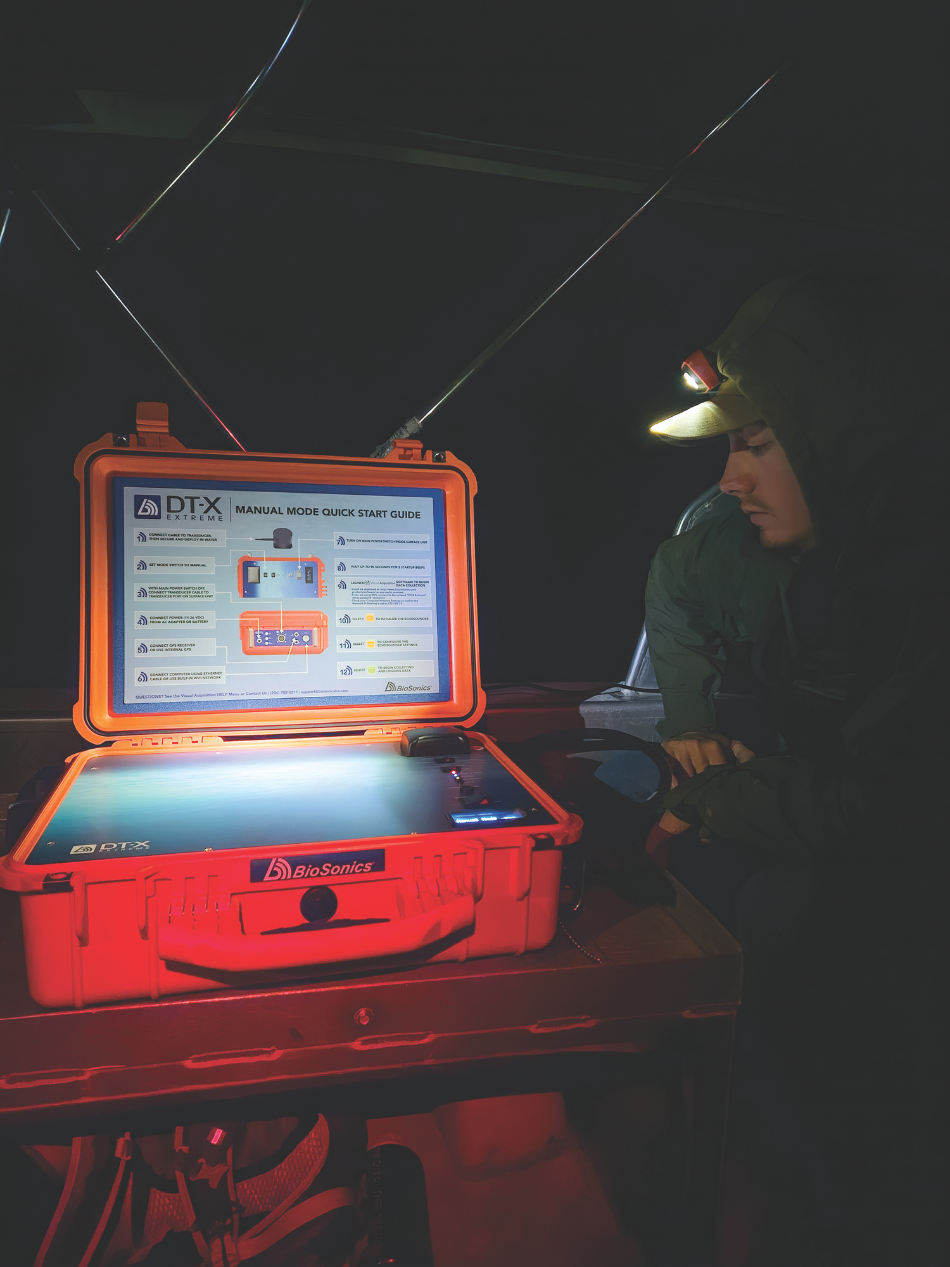
Colton Webb, Game and Fish statewide aquatic assessment crew fisheries biologist, studies the processing box that translates information from the hydroacoustic transducers to the computer.
If you are surveying at night, how do you navigate and avoid hitting objects?
We navigate using GPS mapping, and periodically scan our surroundings with a large spotlight to make sure the area we are traveling through is free of obstacles. We also boat around the lake or reservoir in daylight before doing the survey to mark any hazards that need to be avoided.
What species do you survey with hydroacoustic surveys?
Hydroacoustic surveys work best for fish that swim in open water. It is difficult to use these surveys to detect fish that occupy areas close to the bottom because it can be hard to differentiate stationary fish from rocks or other structures.
In Wyoming, hydroacoustic surveys are being implemented most often to monitor kokanee populations. Kokanee are pelagic fish, meaning they occupy open water areas. There is also a lot of interest in kokanee angling, and Game and Fish stocks millions of these fish every year, so monitoring their populations is important for managers.
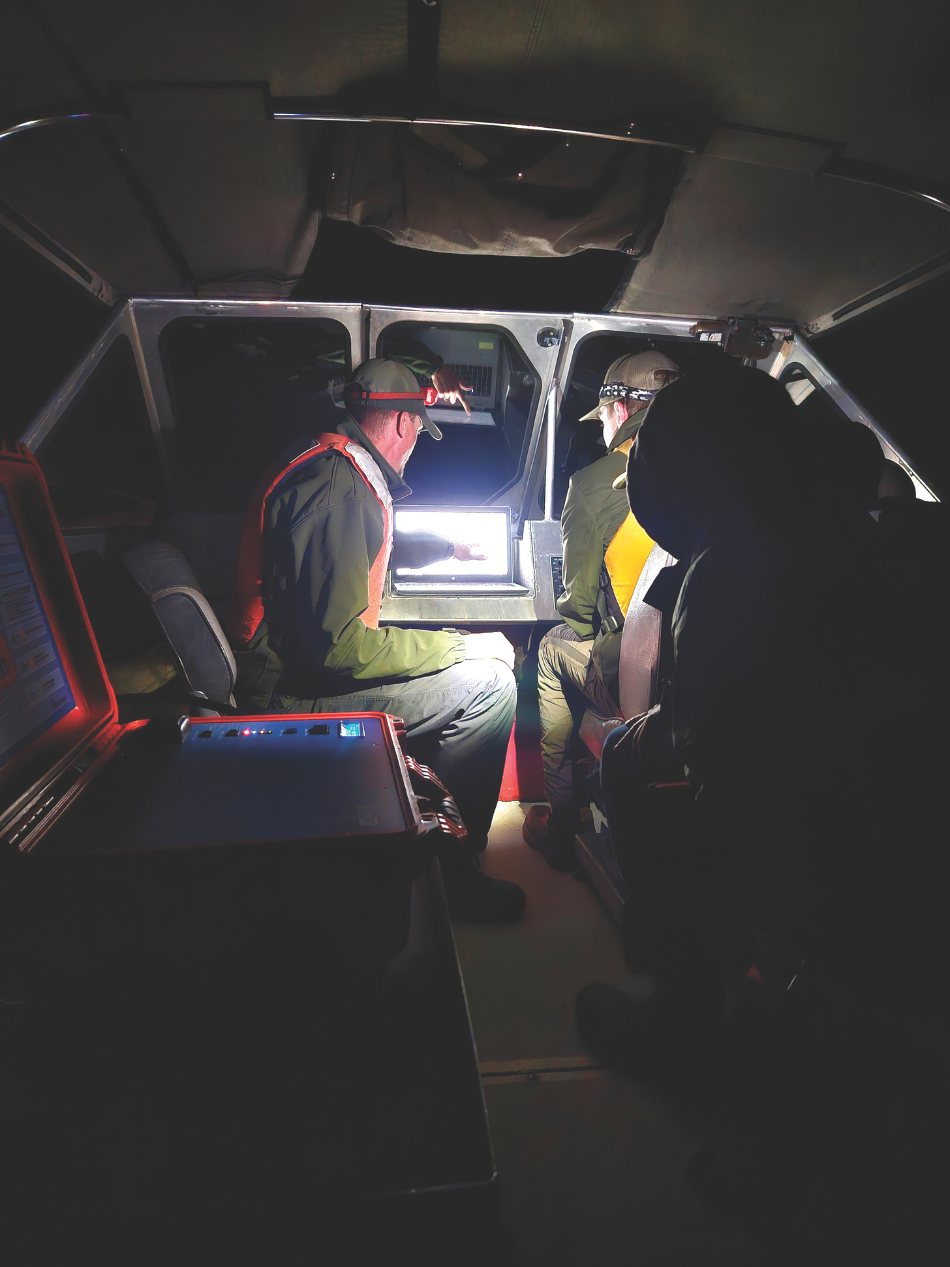
Biologists monitor the hydroacoustic output for recorded fish as they follow predetermined sampling paths across the reservoir.
Where have you done hydroacoustic surveys in Wyoming?
Wyoming has several large lakes and reservoirs that support kokanee populations and have been surveyed with hydroacoustics. In the last few years, we have conducted surveys at Rob Roy Reservoir near Albany and Louis Lake near Lander. We also collaborate with the Utah Division of Wildlife Resources to conduct annual surveys on Flaming Gorge Reservoir.
How certain are your population estimates?
The population estimates we develop are fairly precise, but their accuracy is dependent on how much of the lake or reservoir is surveyed. When we pick a new location for hydroacoustic sampling, the first year we survey a high proportion of the reservoir’s surface area. This gives us the best possible estimate of true population size. We can then look at the data collected and determine how many transects need to be completed to arrive at a population estimate that is within 10 percent of the actual population size. This allows us to maintain a high level of certainty in our estimates, while making the best use of limited time to complete surveys each year.
How is the data used to make management decisions?
Hydroacoustic data is used to monitor changes in fish populations over time. Data can be paired with information like fish length and weight trends to understand population health. For example, if the surveys show a lot of fish but biologists observe the fish are getting skinny, it may indicate that the population has grown too large for the amount of food present for the fish.
Often we perform hydroacoustic surveys on reservoirs where we stock fish like kokanee. In some of these locations, kokanee are stocked but also reproduce naturally, so surveys are critical to understanding the population size. With that understanding, we can evaluate how many fish need to be stocked each year to keep the population at management objectives.
The surveys give biologists a better understanding of how many young fish survive to adulthood, called fish recruitment. This provides managers with insight into what the fishery may look like in the coming years. For example, if a hydroacoustic survey estimates few small kokanee are present, it is likely the adult population will be low in a couple years. Conversely, if a lot of small kokanee are present, managers can anticipate that there will be many catchable fish in the future. This can help managers direct anglers to places where they are likely to have the most fishing success.
— Caroline Rosinski is the information and education specialist in the Laramie Region

